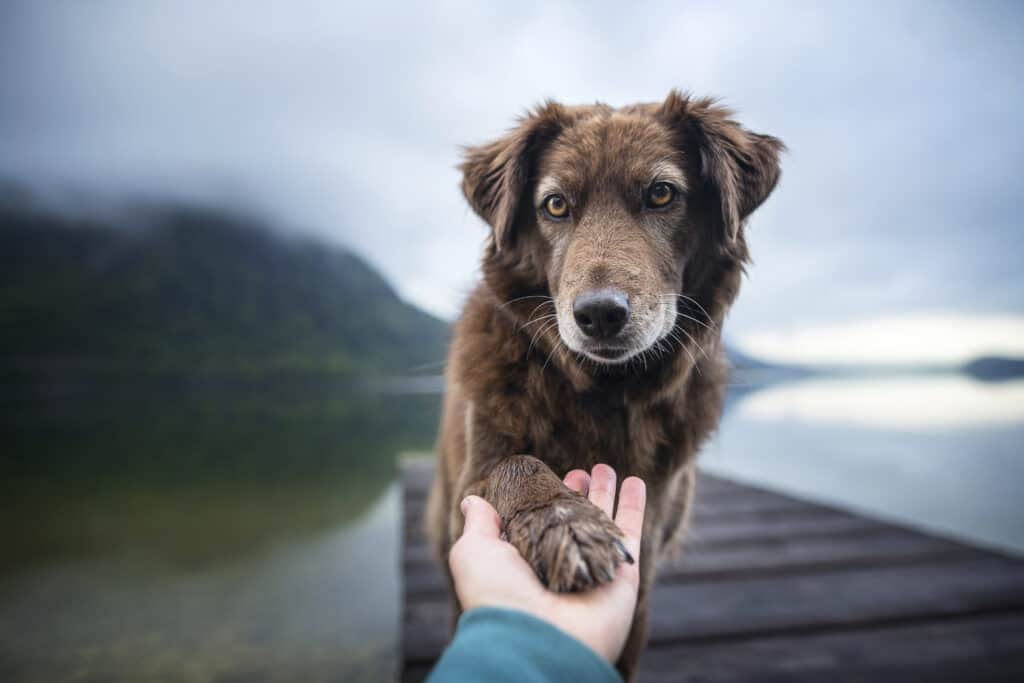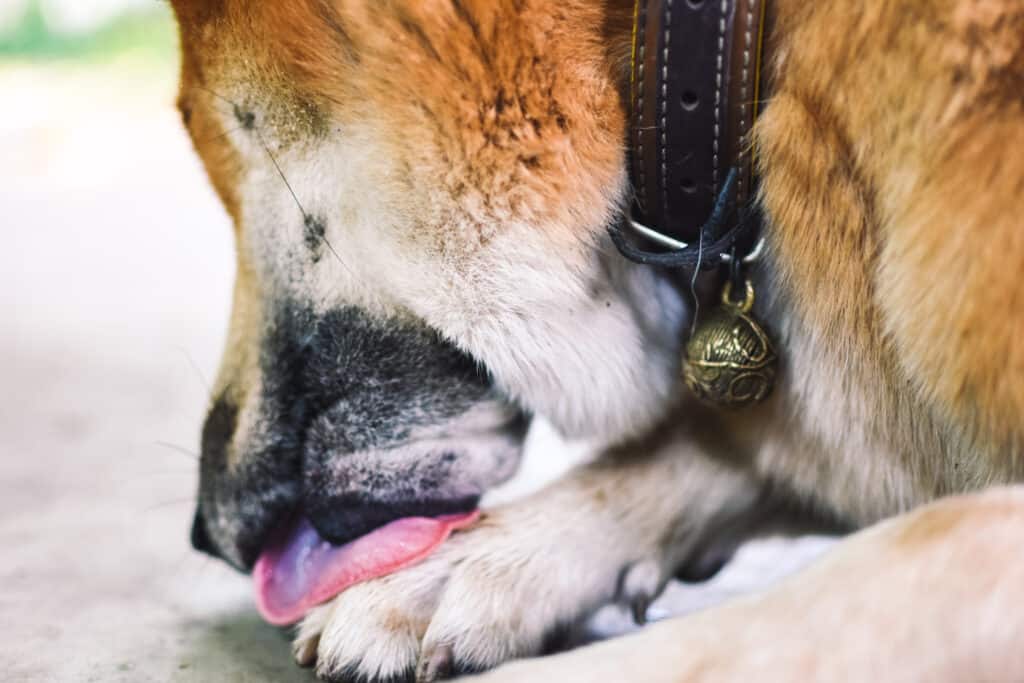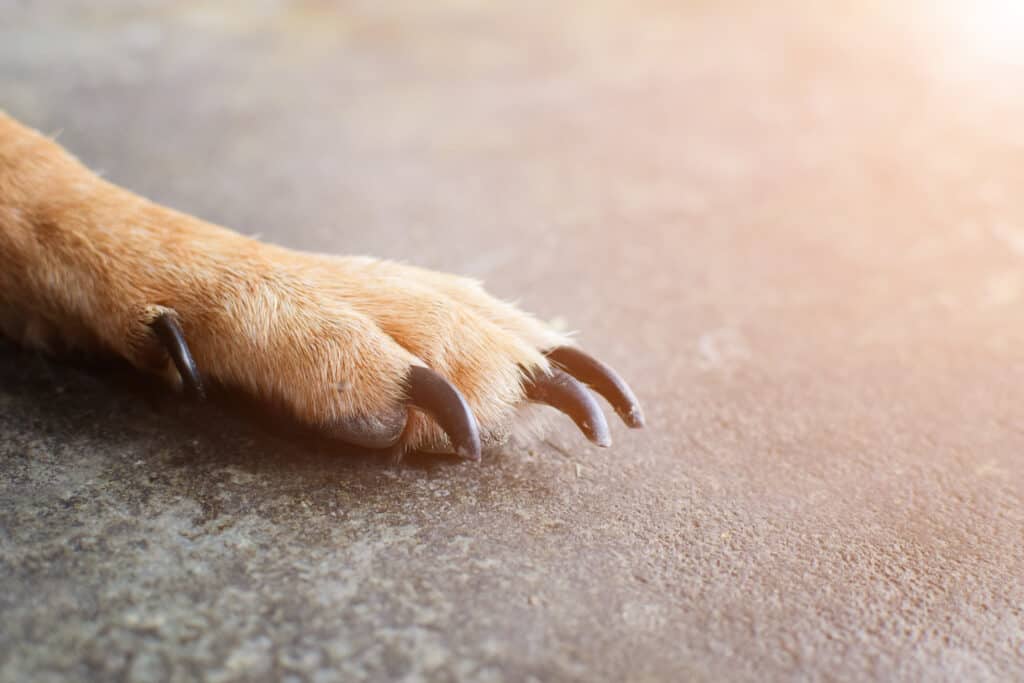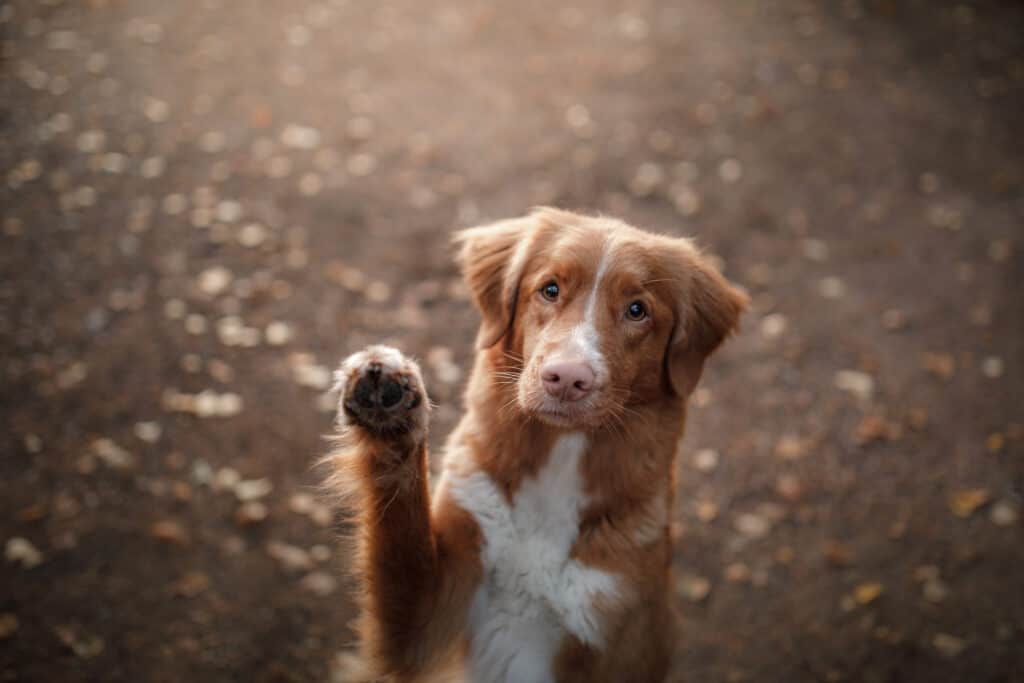*This page may include affiliate links, which means that if you make a purchase through one of the product links, we may receive a small commission. For full affiliate disclosure please see our disclaimer page.
Don’t worry . . . This situation actually happens a lot, so don’t feel guilty or ashamed. You are taking care of the problem now, so let’s just focus on healing your pet. When a dog’s toenail grows extremely long it can curl in towards the foot. And over time it can actually pierce and become embedded in your dog’s paw pad. Sometimes pet parents don’t even notice it until their dog starts limping or licking. The nail can grow in various directions, but when it starts to grow into your dog’s foot it can cause some pain and infection. Here is what to do if your dog’s toenail is curled into their paw.

Do You Need A Vet To Treat A Toenail That Has Curled Into Your Their Paw?
Most of the time, you do not need assistance from a veterinarian when your dog’s toenail is curled into their paw. However, if your dog is extremely painful and sensitive in the area, a vet can administer pain medications and sedatives. If an infection has developed deep in paw tissues then a round of antibiotics may help the foot heal faster.
The Steps To Treating A Dog With a Toenail Curled Into Their Paw:
- Get A Good Look
- Prepare Materials & Supplies
- Cut The Nail
- Remove Ingrown Piece
- Clean Pad Area
- Dry Foot Completely
- Apply Antibacterial Ointment
- Monitor Healing
You need to examine the area to get a good look at what is going on with your dog’s toenail. To accomplish this you might need to clip hair, grab a flashlight or find a friend to assist you.
[ PRO-TIP: I usually have a small flashlight in my doggie first aid kit, but recently I have found that an even better solution is a headlamp so I can use two hands to evaluate the nail problem. ]
After you get a good look at the situation, the next step is to gather the supplies that you will need. The most important materials would include sharp nail clippers, cotton balls, hydrogen peroxide, antibacterial ointment, and someone to help you.
When you are ready, find the tip of the nail to trim. If you cannot tell which end is the tip, just estimate the middle of the curved nail and quickly cut the nail using clean, sharp pet nail clippers. I have found this type of nail trimmer to work the best in this situation.
This step may be uncomfortable for your dog, so cutting the nail quickly can minimize secondary tissue trauma, pinching, squeezing, smashing, and additional nail damage. After cutting the toenail, the end piece will usually fall out on its own. If half of the nail does not fall out, you may need forceps or tweezers to gently pull out the end of the nail.
How To Clean A Wound Left By A Toenail Curled Into Their Paw
After you have removed the nail from the paw pad, you should clean the wound. Lots of dirty stuff could be hiding in there so we need to clean it up. Warm water with a small amount of gentle hand soap will do the trick. The best antiseptic for this situation is regular hydrogen peroxide. Soak a cotton ball with the peroxide and dab it on the wound.
Now, we need to let the area dry completely. At this stage, try not to let your dog lick the toe. I know this is easier said than done. You can distract them with a yummy chew treat, put a sock over the paw, or use an e-collar cone to prevent licking. Usually just supervising them for a few minutes will allow it to dry. Alternately, a blow dryer on the low setting with no heat can speed things along.
After the paw pad has dried completely, we want to apply some sort of antibacterial ointment or cream.

What Do I Do If The Toenail Is Ingrown?
In cases of ingrown toenails, we recommend using a safe antibacterial ointment. This will help heal the paw pad and kick out any infection present. When applying the antibacterial ointment to the paw puncture, use only a small amount and use the original regular strength generic products. Make sure there are no pain relief ingredients nor other additives.
At this time, it pays to make an effort to prevent your dog from licking off all of the ointment right away. If your dog licks the wound excessively then the ointment will not do its job to kick out any infection. On top of that, licking can leave moisture behind which promotes yeast growth and additional bacteria may be introduced from your dog’s mouth.
When it comes to infection on and around paws, dogs actually heal quickly. Some people wrongly assume that paws are at high risk for infection because these parts touch the floor, the grass, dirt, and other yucky areas. But over the years I have seen direct proof of the tough immune system in a dog’s, and other animals, feet. Deep or long lasting infections are rare and most cases do not need oral antibiotics.
SIDE NOTE: However, if your veterinarian recommends antibiotics due to the extent of the infection, make sure to take the medication as directed and always finish the whole course.

How Do These Curved Ingrown Nails Happen?
Nails that are curled and growing into your dog’s own paw pad are usually caused by toenails that are not trimmed nor worn down naturally. Dog toenails are designed to dig in dirt and grip things. When running or chasing, the toenails give extra traction to their feet. So, if your dog is not hitting the trails or pounding the pavement, nails are not worn down naturally and trimming will be needed. As your dog’s nails become longer, they start to curve downwards and continue back towards the toes. If they get long enough, they will grow under the foot near the paw pads. Then each step will cause the nail to dig into the bottom of the paw pad. At this stage, pain and discomfort could be present although animals are really good at hiding pain.
Which Dogs Are More At Risk for Nails Curled Into The Paws?
Ingrown nails can happen to any dog, but certain qualities can make some dogs at a higher risk for this occurrence. These curled nail conditions happen more frequently in small breed dogs and happen more often in older dogs. Senior dogs usually receive less exercise than younger dogs. Other risk factors include breeds with dew-claws or double dew-claws. Additionally, nail curvature may change due to past injuries or trauma.

What Are The Signs Of A Dog’s Nail Curling Into Their Foot?
So, how do you know if a dog’s nail has curled into their paw?
Signs or symptoms that your dog has an ingrown toenail could include:
- Licking or chewing the toe
- Bleeding from foot
- Yelping or growling in pain
- Smelly infection or discharge
- Pinkish swelling around the toes
- Limping or favoring a paw

How Can I Prevent Ingrown Nails In My Dog?
Okay, you have now clipped your dog’s curled nail and followed the healing steps described above. You should want to know how to prevent these painful situations in the future. The easiest way to prevent a nail-to-paw pad clash is to trim your dog’s nails regularly. Get into a routine and start by clipping nails every two weeks. Then move to every 3 weeks, then 4 weeks, etc. These small trims will help the nail quick recede to a more natural length.
[ PRO-TIP: Using a Dremel or grinding tool also stimulates the nails to regress to a normal shorter position. The vibrations of the grinder act as a body signal that nails are too long and that they are hitting the ground forcefully with each step. When used appropriately, Dremel-type tools do not hurt, but may “tickle” some dogs. ]
Getting your dog more exercise will also help prevent these injuries. Keeping your dog active will help them stay healthy and look great in more ways than one. Monitor your dog’s nails and feet, checking at least once a week. You can put a recurring reminder on your smartphone calendar to send yourself reminder notifications.
There are Tons of Resources To Help You Maintain Your Pup’s Toenails At Home
You can order the maintenance supplies you need online and can watch hundreds of YouTube videos demonstrating how to clip your dog’s nails. Give yourself some time and go slow as you navigate this important part of health maintenance. However, I also know how intimidating it can be to trim your dog’s nails. It is surprisingly common for those of us in the animal care field to not be able to trim our own personal dog’s nails. If you try but cannot make the situation a positive one, then go ahead and call your vet.
Other helpful resources are pet groomers and pet stores. In some areas, they even have mobile nail services for dogs! A nail expert, like Nailed it! Denver comes to your home at a scheduled time, trims your pup’s nails, and even sweeps up the mess! Just follow the steps above to fix the toenail, and your furry family member will be stepping pain-free soon!
Check out our other articles for even more knowledge to keep your dog healthy and happy!
7 Beneficial Herbs For Dogs That You Can Grow In Your Garden
Can Dogs Eat Blueberries? Are Blueberries Good For My Dog?
Let us know your dog’s name on your favorite social media platform.
